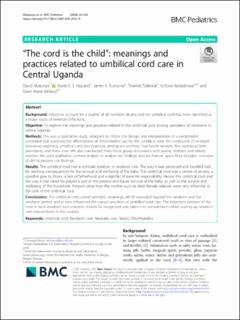| dc.contributor.author | Mukunya, David | |
| dc.contributor.author | Haaland, Marte Emilie Sandvik | |
| dc.contributor.author | Tumwine, James K | |
| dc.contributor.author | Tylleskär, Thorkild | |
| dc.contributor.author | Nankabirwa, Victoria | |
| dc.contributor.author | Moland, Karen Marie Ingeborg | |
| dc.date.accessioned | 2021-01-12T08:09:15Z | |
| dc.date.available | 2021-01-12T08:09:15Z | |
| dc.date.created | 2020-03-05T07:22:59Z | |
| dc.date.issued | 2020-03-04 | |
| dc.Published | BMC Pediatrics. 2020, 20, 105. | |
| dc.identifier.issn | 1471-2431 | |
| dc.identifier.uri | https://hdl.handle.net/11250/2722452 | |
| dc.description.abstract | Background: Infections account for a quarter of all newborn deaths and the umbilical cord has been identified as a major route of newborn infections.
Objective: To explore the meanings and practices related to the umbilical cord among caretakers of newborns in central Uganda.
Methods: This was a qualitative study, designed to inform the design, and interpretation of a randomized controlled trial assessing the effectiveness of chlorhexidine use for the umbilical cord. We conducted 22 in-depth interviews exploring umbilical cord care practices among ten mothers, four health workers, five traditional birth attendants, and three men. We also conducted three focus group discussions with young mothers and elderly women. We used qualitative content analysis to analyze our findings and we borrow upon Mary Douglas’ concepts of dirt to present our findings.
Results: The umbilical cord had a symbolic position in newborn care. The way it was perceived and handled had far reaching consequences for the survival and wellbeing of the baby. The umbilical cord was a centre of anxiety, a possible gate to illness, a test of fatherhood and a signifier of parental responsibility. Hence, the umbilical cord and the way it was cared for played a part in the present and future survival of the baby, as well as the survival and wellbeing of the household. Persons other than the mother such as older female relatives were very influential in the care of the umbilical cord.
Conclusions: The umbilical cord carried symbolic meanings, which extended beyond the newborn and the newborn period, and in turn influenced the various practices of umbilical cord care. The important position of the cord in local newborn care practices should be recognized and taken into consideration when scaling up newborn care interventions in the country. | en_US |
| dc.language.iso | eng | en_US |
| dc.publisher | BioMed Central | en_US |
| dc.rights | Navngivelse 4.0 Internasjonal | * |
| dc.rights.uri | http://creativecommons.org/licenses/by/4.0/deed.no | * |
| dc.title | “The cord is the child”: meanings and practices related to umbilical cord care in Central Uganda | en_US |
| dc.type | Journal article | en_US |
| dc.type | Peer reviewed | en_US |
| dc.description.version | publishedVersion | en_US |
| dc.rights.holder | Copyright the authors 2020 | en_US |
| dc.source.articlenumber | 105 | en_US |
| cristin.ispublished | true | |
| cristin.fulltext | original | |
| cristin.qualitycode | 1 | |
| dc.identifier.doi | https://doi.org/10.1186/s12887-020-2002-9 | |
| dc.identifier.cristin | 1799712 | |
| dc.source.journal | BMC Pediatrics | en_US |
| dc.source.40 | 20 | en_US |

